How to Photograph the Northern Lights (eBook)
$27.00Digital Download (updated 1/10/2022)
Digital Download (updated 1/10/2022)
PDF format (approx 100MB) English
3rd Edition: V3.8 | Updated 1/10/2022
330 pages | 150+ photos | 150+ illustrations
If learning how to photograph the northern lights is on your bucket list, then this eBook is a must. “How to Photograph the Northern Lights” is a wonderfully illustrated, comprehensive tutorial that will equip you with all the necessary information to capture your photos of the northern lights successfully.
Two long-time Alaskans and specialists in their fields, photographer Patrick Endres and scientists Neal Brown, have teamed up to create “How to Photograph the Northern Lights,” an information-rich resource on the aurora. Whether you are a beginner photographer or an advanced professional, there is something in this eBook for you. Patrick liberally shares secrets from his multi-decade career of chasing and photographing the northern lights, and Neal sheds light on aurora science.
“How to Photograph the Northern Lights” is filled with many do’s, don’ts, and insights that only come from extensive time and experience in the field. Be prepared by tapping into this resource before you invest heavily in a northern lights photo quest.
“‘How to Photograph the Northern Lights’ is more than outstanding. What an awesome job Patrick did. He covered everything thoroughly. His incredible images only surpass his rhetoric and understanding. Thank you so much for sharing your vast knowledge of this magical phenomenon. This is by far the best aurora book and one of the best photography books I have read.”
Jackie Orsulak, North Carolina
“Only the gazillions of trips out to photograph the aurora could render the thoughtful, practical insight this little concentrated book yields! This source of experience and scientific background will prepare anyone heading out into the cold to photograph the aurora…There are HEAPS of value in this one ebook for any photographer looking to photograph a star-filled sky, photographing in the cold North, or as fascinated by the science and art of photographing the aurora.”
Sue Rakes, Master Photographer
“This book is the authority on photographing the Aurora. Beginning photographers to seasoned pros will learn valuable tips from Patrick’s vast experience photographing Aurora in the far north. Not only does Patrick explain photographing the Aurora, but he shares valuable information on predicting displays, dealing with the cold, and composition guidelines. All this is illustrated with stunning Aurora Borealis images.”
Tom Bol, Professional Photographer

Patrick Endres is one of Alaska’s most prominently published professional nature photographers. In “How to Photograph the Northern Lights”, he shares the secrets of a multi-decade career of aurora photography and provides you with the critical information to make sure your aurora photography venture is successful.
“Over the years, I’ve seen countless errors made when photographing the aurora. This book equips both the beginning and professional photographer with all the necessary insider information to skip those costly mistakes—and offers the inspiration for the armchair photographer to get out there and explore the night skies on their own.”
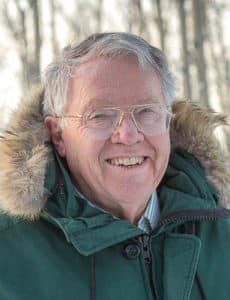
University of Alaska Geophysical Institute professor emeritus and aurora specialist Neal Brown supplies the answers in layman’s language to often-asked questions about the northern lights in his science notes sprinkled throughout the book. Neal frequently lectures on the northern lights and aurora science to laymen audiences.
My longtime fascination with the aurora has also involved photography, with varying degrees of success. Before I bought my first digital camera, I spent hours searching the Internet for information on photographing the aurora and processing the digital images. Along the way, I discovered Patrick’s website and helpful insight on the subject.
Where to go
What month and season is best
What time of night is best
How to dress appropriately for the cold
Working with camera gear in the cold
What camera and lens to use
Tripods, headlamps, and other essential gear
How to read aurora forecasts
Composition and depth of field
How to properly expose
Moon and moonlight considerations
Tips for working in the dark
Helpful apps
And much more.
Each chapter in “How to Photograph the Northern Lights” contains a blend of technical and creative information that both the beginner and professional photographer will find invaluable. The text is augmented with 150+ of Patrick’s luminous aurora photos, thoughtful quotes, and 150+ illustrations, graphs, and figures to instruct you in the do’s and don’ts of nighttime aurora borealis photography. Full table of contents listed at the bottom of the page. Below are a few sample excerpts from the eBook.
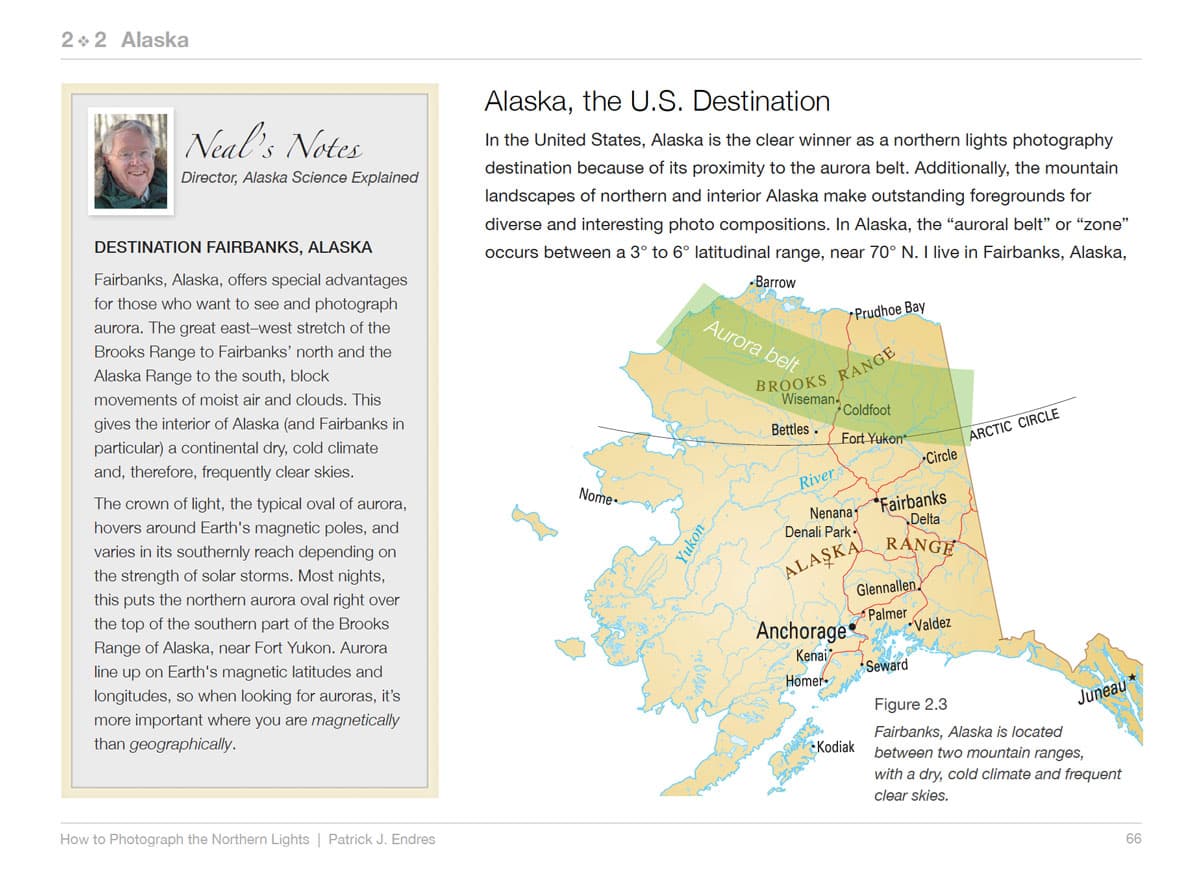
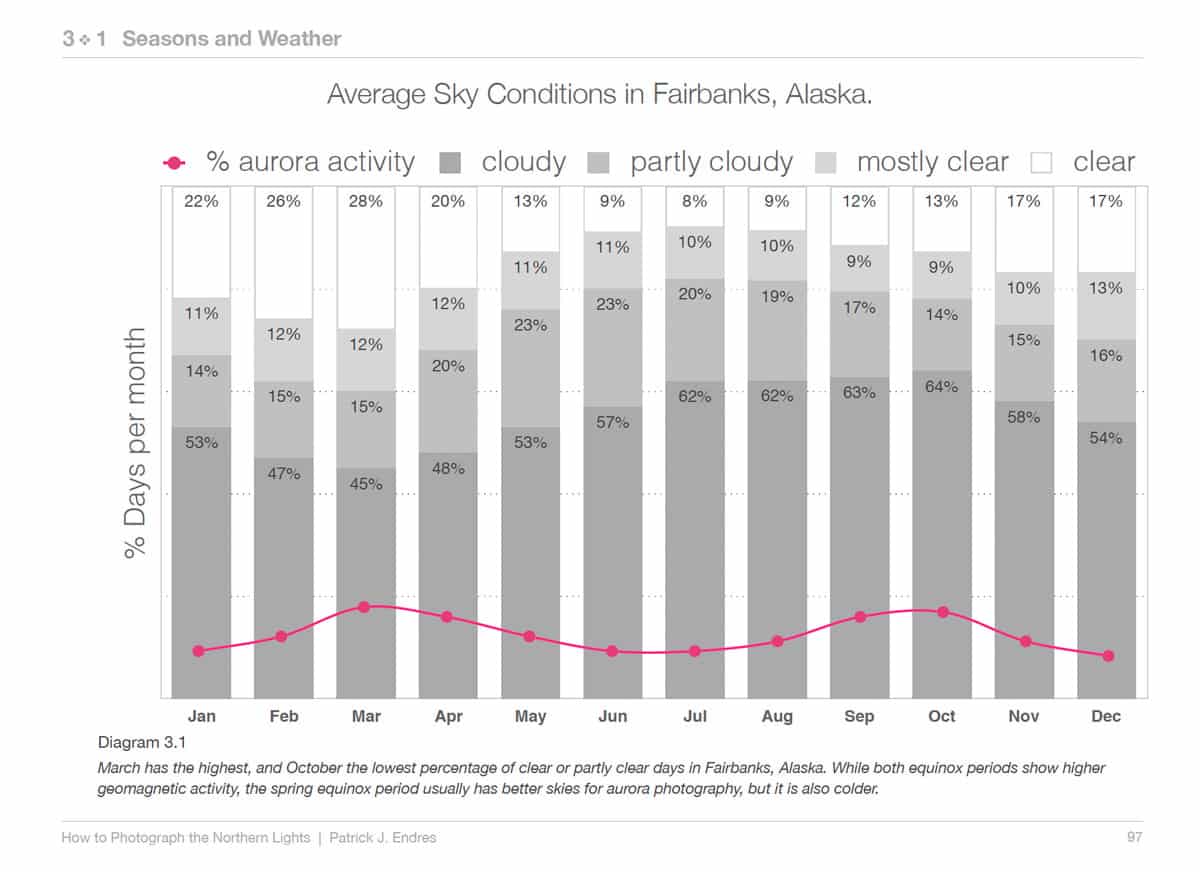
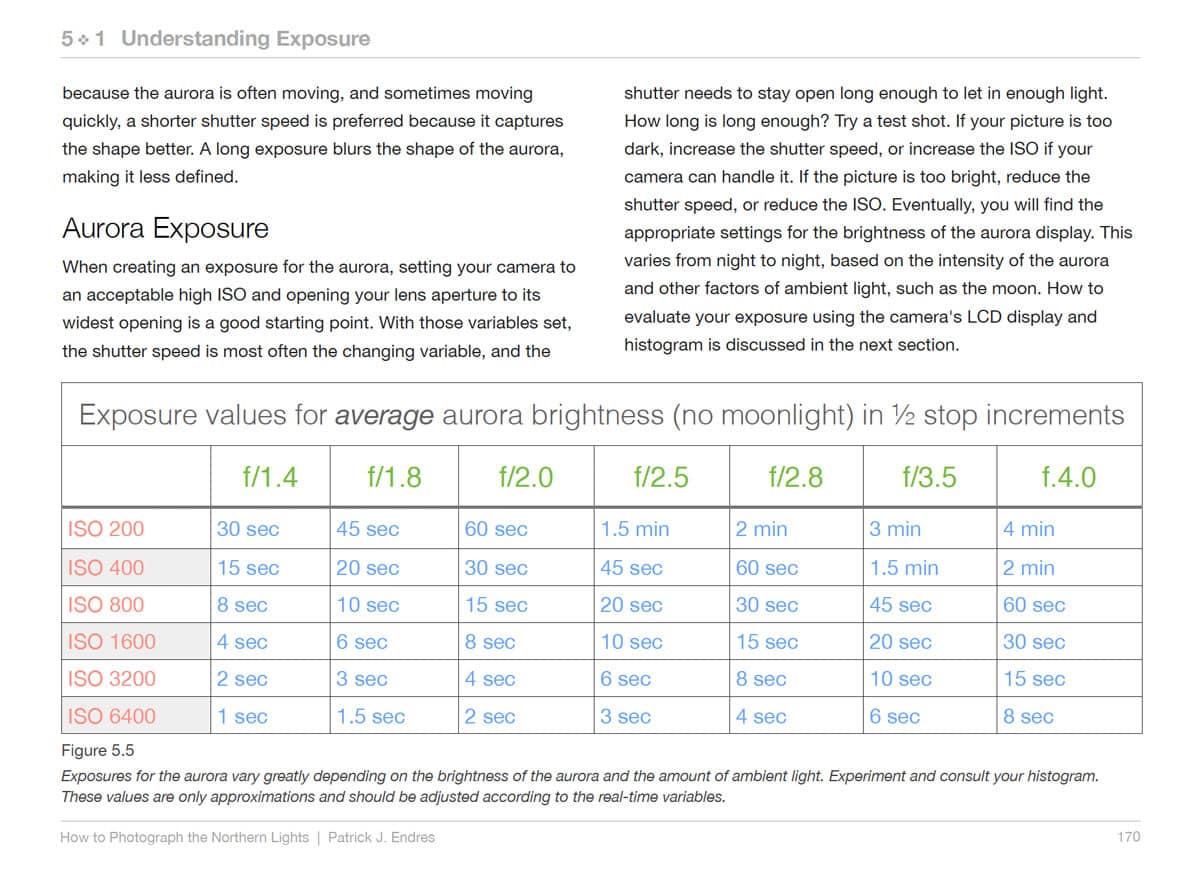

How to appropriately dress when photographing in cold conditions

Considerations and recommendations for dealing with cold weather and your camera gear.

Understanding the exposure relationship to optimize photography opportunities.
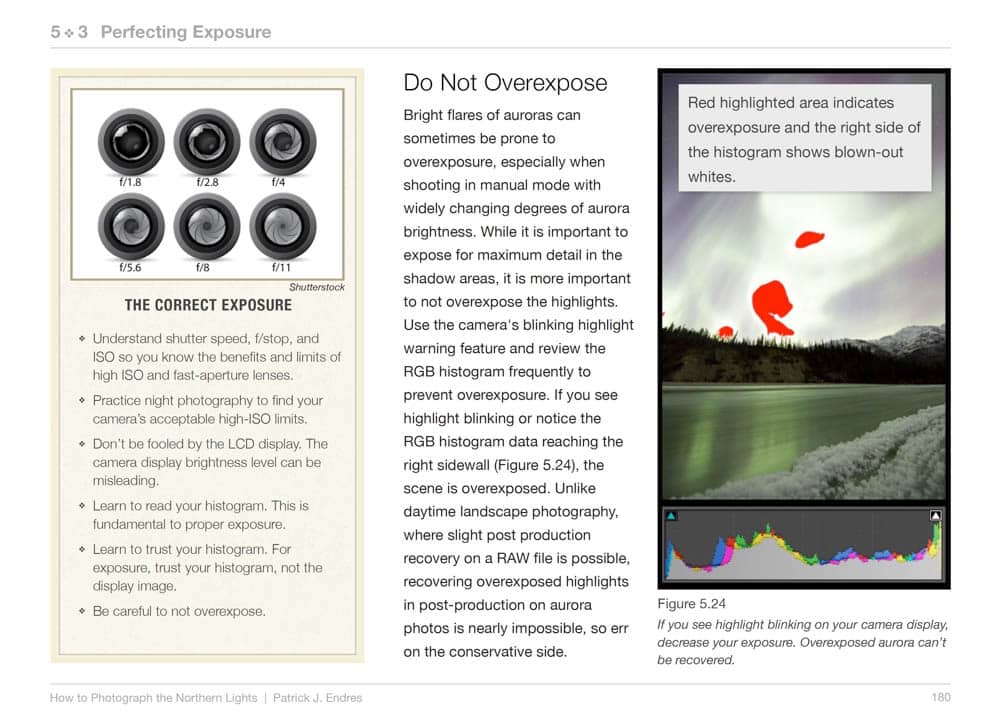
The cardinal rule: DO NOT OVEREXPOSE!!
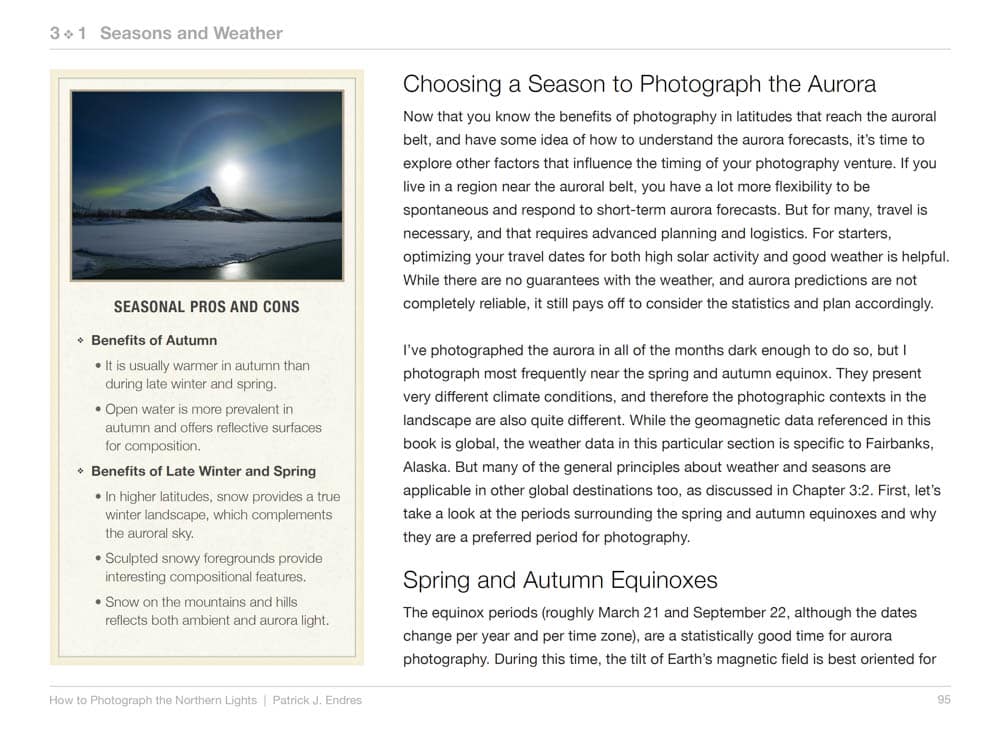
“Only the gazillions of trips out to photograph the aurora could render the thoughtful, practical insight this little concentrated book yields! This source of experience and scientific background will prepare anyone heading out into the cold to photograph the aurora (wished I had this to learn backward and forward up to 10 years ago on my first trip North). Patrick has shared valuable in-the-field secrets in his signature generous style (second only to his in person presentation on his photo tours). There are HEAPS of value in this one ebook for any photographer looking to photograph a star-filled sky, photographing in the cold North, or as fascinated by the science and art of photographing the aurora.”
~ Sue Rakes
Master Photographer
USA
“This book is the authority on photographing the Aurora. Beginning photographers to seasoned pros will learn valuable tips from Patrick’s vast experience photographing Aurora in the far north. Not only does Patrick explain photographing the Aurora, but he shares valuable information on predicting displays, dealing with the cold, and composition guidelines. All this is illustrated with stunning Aurora Borealis images.”
~ Tom Bol
Professional Photographer
USA
“If you dream about chasing the Northern Lights then buy Patrick J. Endres’ book because it will strengthen your resolve and encourage that dream. If you have an actual plan to try to see them then this book is an essential read. As we would expect from Patrick, it is magnificently illustrated with thought provoking quotations, but it is much more than a pretty ebook. This is a substantial and authoritative work, with contributions on the science of the aurora borealis from Neal Brown. Yet it is a compelling and enjoyable read and extremely well laid out. You will learn where, when and even what time to photograph the Northern Lights, how to prepare, what to wear, how to actually capture them on camera and much more. This is the book to read on the Northern Lights.”
~ Cecily O’Toole
USA
“I LOVE THE BOOK! I downloaded it on my iPad and read it in one night. Am taking it with me next week to Alaska where I am sure I will refer to it time and time again. Thank you Patrick. My only suggestion for future editions would be to make it easier to navigate.”
~ Diana Frost
USA
“This is an absolutely ‘must read’ book for anyone hoping to photograph the Aurora. I’m off to Northern Norway (Tromso) on March 10 (New moon)and for the first time feel really well prepared. I picked all kinds of tips – and the checklists are brilliant as a last minute form of preparation. Nothing is left to chance in this wonderfully illustrated book. Highly recommended!”
~ Sam Hall
United Kingdom
“This is a remarkably well designed book, well suited to viewing on a screen of your choice. You get not just the how, but enough where and why to build an understanding of the phenomena. I appreciate the practical details surrounding actually photographing — lenses, iso, care of both the photographic equipment and the photographer in the cold. I hope that this is the first of a series of ebooks on photography in Alaska.”
~ Marvin Falk
USA
“I just purchased your book (as pdf, I could perfectly open it) and also via iTunes on my i-pad when I am underway. I had a first glimpse and will read it in the coming days with very much interest: a very complete book, and even when I am already 7 years photographing the aurora, there is always some new stuff I will learn !! Not only how to photograph the Northern Lights is explained, but also some technical side aspects as clothing, material, some statistics, post-production of the pics, avoiding mistakes etc etc … a book I was waiting for. Thank you again, Patrick, and keep up the nice work. You have indeed excellent aurora and awe-inspiring aurora pictures.”
~ John Van Marcke
Belgium
“Just wanted to let you know I have been able to open it and your advice is priceless! Thank you so much for sharing your knowledge with us non-professional folk! I took some pictures last night and feel much more confident with the results after taking the advice you offer in your book. I am heading out there again tonight and hope to shoot at least one picture which I will feel confident enough about to have printed and hung on my wall! That’s if there is activity tonight, but I am being very hopeful there will be.”
~ Sanet Basson
South Africa
“Just bought the book in pdf form so I can reference it on my upcoming trip to Alaska using my laptop, and also bought the itunes version for my wife’s iPad. Really fantastic so far, as I’m reading every word and loving it. The science part of it is very understandable, and I like how it is separated out on the page. Patrick’s tips and advice are critical, and it was Patrick’s website six months ago that inspired our planning of this imminent trip. I just love the quotes by famous photographers at the beginning of each chapter. These really resonate with me. And Patrick’s photographs are so inspiring, as teaching examples, and for their incredible beauty! I’ll post more after I finish the book and come home from the adventure of photographing The Northern Lights!”
~ Mike Shaw
USA
“Since 2007 I used to travel to Lapland every February/March for hunting daytime / dawn lights and nothern lights- first with analogue Canon EOS, later on with EOS 7 D. Just being in Swedish Lapland I found your book and devoured it last weekend…..you have done an excellent job by writing this fantastic book full of informations. Especially the detailed diagrams, tables and links are extremely helpful. With your recommendations my pictures really improved (fortunately we have a lot of northern lights for trying different settings) and last night I caught wonderful northern lights with a lot of clear stars, with a shooting star, and green horizontal lights with a vertical red curtain. Your book will join me on all following tours, thanks again. If wished you can put this email on your website as example for enthusiastic customers.”
~ Dr.Iris Ernst
Germany
Hey just wanted to thank you for all the great advice…I rented the Canon EOS 5D MKII and the Canon 24mm IIL F/1.4 lens with a good Ball type tripod… I was not sure I wanted to invest that amount of money without trying it out first and the rental was a great option. Thank you for making it possible for an “amateur” to take some great photos…..there were probably 30 others that went up to get photos….but I was the only one prepared (even though I was up from Texas) all thanks to you.
~ Thomas Kepczyk
USA
“Our family just came back from a week+ trip into and around Fairbanks. We went specifically to see the aurora and studied Patrick’s advice religiously before we started our trip. Like many before us I’m back to report the advice was priceless!!! We felt very prepared, came back with tons of great photos (we got very lucky with clear nights and two level 4 aurora alert nights) and lots of great memories….the advice on cold weather gear, camera equipment and locations was excellent. Can’t thank Patrick enough for all his experience, advice and (more than anything else) his willingness to share all this.”
~ Rick LaRosa
USA
“Hi Patrick, I bought your book for a northern lights trip to Tromso and Spitsbergen a few months ago. I am a serious photographer yet this book gave me a wealth of knowledge that I was unaware of, and definitely helped me bring back better images. This is the best reference book I have seen, so congratulations, your images are extraordinary.”
~ David Worswick
SOUTH AFRICA